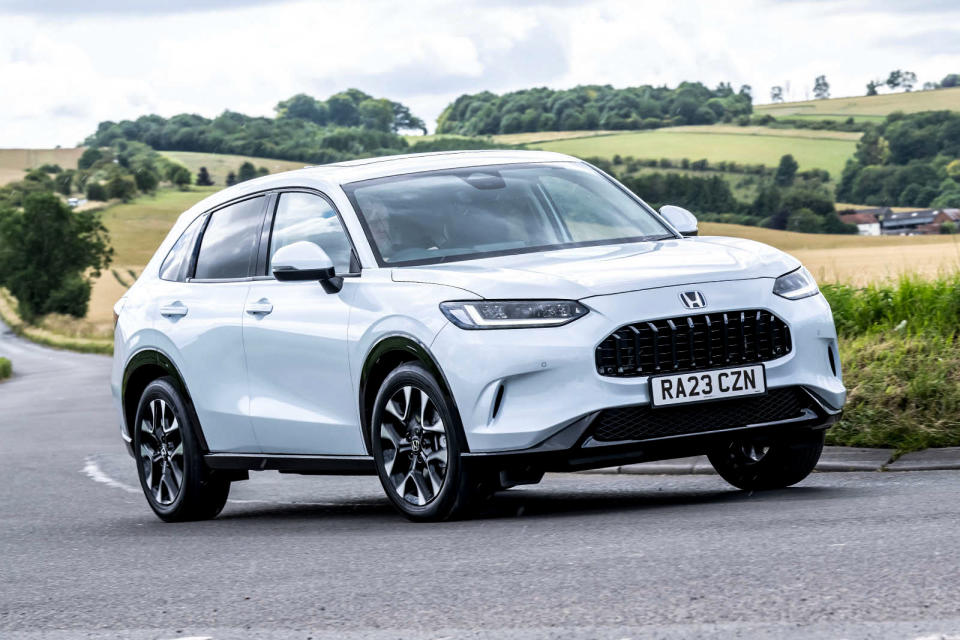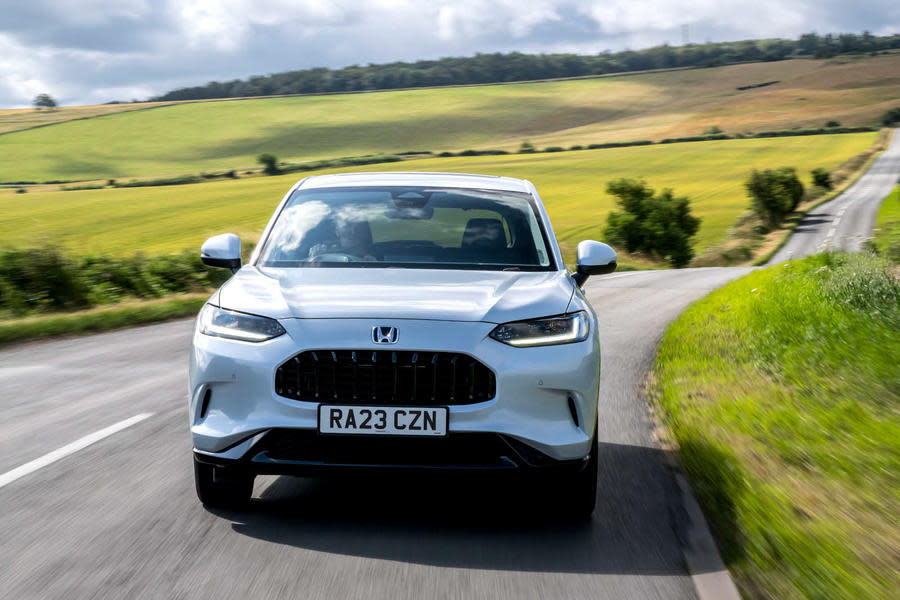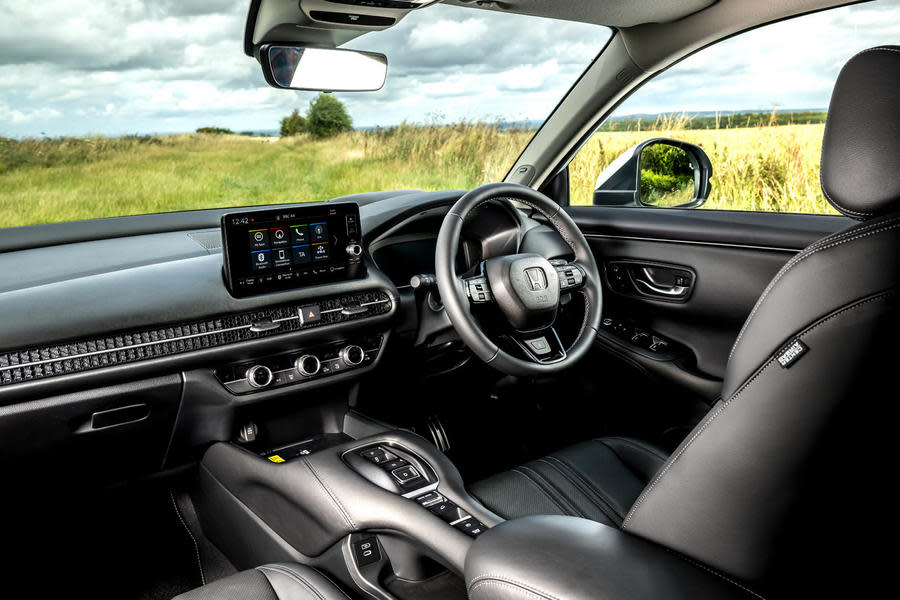Honda ZR-V

As cars go, the Honda ZR-V is a rather important one for Honda.
After seeing a gap in its range, mainly created by the new Honda CR-V (due later this year) growing substantially to compete with cars like the Hyundai Santa Fe, the Japanese brand decided it needed to act. Mainly because that gap meant customers were instead opting for the likes of the Kia Sportage and Nissan Qashqai.
“Our dealers are very excited by this car,” Honda’s UK product boss, Andrew Winfield, told Autocar. “We expect to see a lot of conquest sales.”
You can see why. Look beyond the odd naming strategy – the ZR-V sits atop the Honda HR-V but below the CR-V – and this is basically a Honda Civic SUV. At 4568mm long, it’s near enough the same size as the hatchback, just a bit taller.

The ZR-V – first UK deliveries of which begin in September – also shares much of its technical make-up with the Civic. In Europe, Honda is offering it exclusively with the same hybrid powertrain.
The naturally aspirated 2.0-litre four-cylinder Atkinson-cycle petrol engine produces 141bhp, but it mainly serves to spin a generator and either power the 181bhp electric motor or buffer the energy in the 1.05kWh battery. Most of the time, the engine doesn’t drive the wheels directly, but at a motorway cruise, a clutch in the transaxle can close to connect the engine to the front wheels through an overdrive gear.
Because the engine isn’t physically connected to the wheels most of the time, the software can make it do whatever it wants, so at lighter loads, the engine could be doing anything. It could be off, it could be pretending it’s connected to either a CVT or an eight-speed automatic gearbox, or it could be holding a set number of revs to charge the battery.
That’s all familiar from the latest Civic. Where the ZR-V is different is inside, but only a little. Much of it is Civic as well. The dashboard has the same design, featuring a horizontal strip of air vents, and the clicky buttons for the climate control are as welcome as ever. The 9.0in touchscreen for the infotainment isn’t the crispest and its sat-nav system isn’t especially clear, but the shortcut buttons and wireless smartphone mirroring mean it’s largely pleasant to use.
Generally, the materials have had a gentle uplift compared with the Civic, with more soft-touch stuff on the doors and a more sculpted centre console with storage underneath. (Unlike with the Civic, there won’t be a manual version of the ZR-V sold anywhere in the world, so no space needs to be reserved for a shift linkage.)
The ZR-V also has metal paddles (used in this case for swapping brake regeneration levels), which is a first in a Honda since the iconic NSX. Now that’s some pub trivia
Yet, despite the nice interior, one thing does stick out as odd: the driving position. It’s the same as in the Civic, just slightly higher. The Civic sits you low, with your legs outstretched, in a comfortable seat with a good amount of adjustment. That’s great for a hatchback, but a lot of people buy SUVs for the slightly more upright seating position, so it feels a bit as if the ZR-V is trying to please the people who prefer a hatchback anyway. This could be a big strength for some buyers, but also a negative for others.

The rear cabin space is generous, with good leg room and head room and a very shallow centre tunnel. The same grade of materials as in the front is used in the rear, and there are two USB ports and air-con vents, so the rear passengers won’t feel like they have ended up in the cheap seats.
The boot, by contrast, is rather small for the class. The ZR-V’s 390-litre capacity is down quite significantly on the hybrid versions of the Kia Sportage (587 litres) and Nissan Qashqai (504), and even the Civic (410). It’s practical enough, with a flat floor and a panel that can flip up to form a divider, but it ought to do better. The capacity drops to 380 litres in the top-spec Advance trip, due to the Bose sound system
Fans of Honda’s Magic Seats (which flip up cinema-style to let you load tall items in the footwells) will be disappointed too. As with the Civic, Honda prioritised ride and handling so used a multi-link rear axle instead of a more compact twist-beam one. That meant the fuel tank had to go in the usual spot, under the rear bench, making the Magic Seats impossible. The Honda Jazz and HR-V are the only two cars in the line-up to still have the Magic Seats.
Which raises the question of whether the ride and handling are worth the slight loss of practicality. That depends on how often you might use those Magic Seats and just how much handling verve you desire from your family crossover. We suspect that for most potential buyers the answer will be ‘no’.
That said, the ZR-V does ride and handle more keenly than some comparable cars, with weighty, responsive steering and a limited amount of body roll. On UK roads, especially pothole-ridden B-roads, the SUV glides with relative ease thanks to its nicely damped suspension. But a hint of firmness results in some chucked-about moments, especially at speeds on in-need-of-repair dual carriageways.
In general, if you’re looking for ride and handling excellence, you won’t find it in a family crossover, but the ZR-V is at least at the top of the class. The biggest compliment you can give is that it handles like the excellent Civic, albeit with more rocking due to the ZR-V’s taller nature. It does, however, do a better job than its hatchback counterpart of isolating you from road and wind noise.

Given that the powertrain is lifted from the Civic, you might expect our comments on it in the ZR-V to be a case of 'see Civic review', but that’s not the case, because two changes mean it’s not quite as impressive as in that car. First, it has about 100kg more to deal with. Second, the ZR-V lacks some of the Civic’s digital noise reduction. We have never remarked on it when reviewing the Civic, but it now seems that it does quite a bit to take the thrashiness out of the engine note, because that’s more present in the ZR-V.
The drive system also doesn’t seem to behave quite as consistently either. When you demand some acceleration, sometimes the ZR-V will deliver it smoothly and silently as the Civic usually does, but at other times, the same throttle input will prompt the engine to rev – and, as noted, this results in quite an angry tone.
By making its family crossover so similar to its family hatchback, Honda has set it up for some cruel comparisons. The ZR-V is much like the excellent new Civic but very slightly worse in every way. That’s par for the course, but other manufacturers have disguised that fact by differentiating their crossovers and hatchbacks more clearly – or indeed by axing the latter altogether.
Giving it much the same driving position as the hatchback is an odd choice as well, but so long as that suits you, the ZR-V is one of the stronger options in the class thanks to well-set-up ride, handling, comfort, and multimedia, as well as mature assisted driving features, good performance and fuel economy
What might hold the ZR-V's back its price. It starts at £39,495 for the Elegance grade. That's the same as the most expensive Renault Austral, and not far off the most expensive Kia Sportage Hybrid or Nissan Qashqai e-Power. Sport costs £41,095 and Advance, which adds leather, a panoramic roof, Bose hi-fi and a few more things, rises to £42,895.
Compared with the Civic which starts at £36,495 and tops out at £39,795, that’s also just a smidge more, which Honda hopes will push families looking for Civic-like cues but in need of more space into the ZR-V.
Honda is not discouraged. It has already set its hopes on selling 7000 units a year (5000 between its mid-September launch and next March), with at least 50% being the top-rung Advance trim. Just 10% is expected to be the entry-level Elegance grade. This again follows the Japanese brand’s new aim of not sweating over volumes: “We sell less but we make more money,” said Winfield.
What this car is, then, is good, but sadly not as great as its hatchback sibling. What it does have going for it, though, is its driving similarities to the Civic, and that will, for sure, be a massive pull – especially for those who want the hatchback, but just need a tad more space.

UK driving impressions by Will Rimell
]]>

 Yahoo Autos
Yahoo Autos 